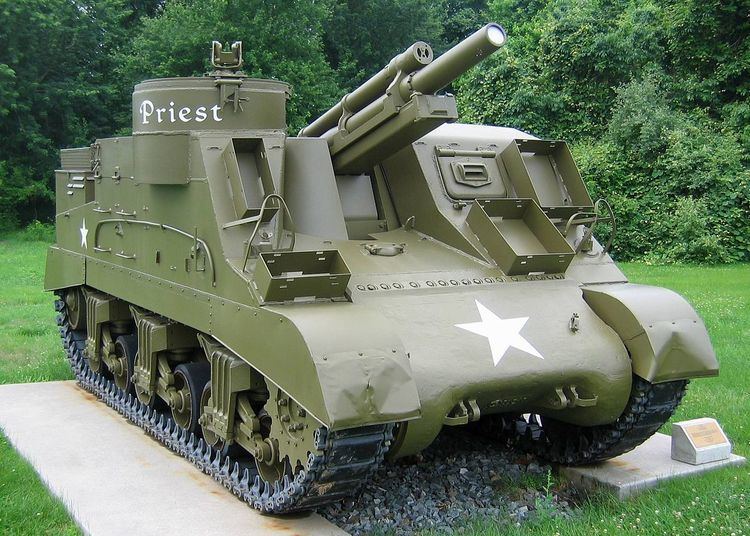Produced April 1942–1945 | ||
 | ||
Type Self-propelled artillery Used by U.S. ArmyArgentine armyBelgian armyBritish ArmyCanadian ArmyIsrael Defense ForcesPakistan ArmyPhilippine ArmyPhilippine ConstabularyTaiwanese Army Manufacturer American Locomotive Company (M7)Pressed Steel Car (M7, M7B1)Federal Machine and Welder (M7B2) No. built M7: 3,490 M7B1: 826 M7B2: 127 | ||
The 105 mm Howitzer Motor Carriage M7 was an American self-propelled artillery vehicle produced during World War II. It was given the official service name 105 mm Self Propelled Gun, Priest by the British Army, due to the pulpit-like machine gun ring, and following on from the Bishop and the contemporary Deacon self-propelled guns.
Contents
History
Witnessing the events of the war, U.S. Army observers realized that they would need a self-propelled artillery vehicle with sufficient firepower to support armored operations. Lessons learned with half-tracks (such as the T19 Howitzer Motor Carriage (HMC) with a 105mm howitzer on the M3 Half-track chassis) also showed that this vehicle would have to be armored and fully tracked. It was decided to use the M3 Lee chassis as the basis for this new vehicle design, which was designated T32.
The pilot vehicles used the M3 chassis with an open-topped superstructure, mounting an M1A2 105 mm howitzer and, following trials, adding a machine gun, the T32 was accepted for service as the M7 in February 1942 and production began that April. Before production had begun, the British Tank Mission had requested 2,500 to be delivered by the end of 1942 and a further 3,000 by the end of 1943, an order which was never fully completed.
As the M4 Sherman tank replaced the M3, it was decided to continue production using the M4 chassis (the M4 chassis was a development of the M3). The M7 was subsequently supplanted by the M37 HMC (on the "Light Combat Team" chassis that also gave the M24 Chaffee light tank). While the first M7s were produced for the U.S. Army, some were diverted to support the British in North Africa. Ninety M7s were sent to the British Eighth Army in North Africa, who were also the first to use it in battle during the Second Battle of El Alamein as well as their own Bishop, a self-propelled gun based on the 87.6 mm calibre Ordnance QF 25-pounder gun-howitzer.
The British had logistical problems with the M7, as it used U.S. ammunition that was not compatible with other British guns and had to be supplied to units. The logistical problem was only truly resolved in 1943 on arrival of the Sexton, developed by the Canadians on a M3 chassis, using the standard British QF 25-pounder. Until that time, the British continued to use the M7 throughout the North African and Italian campaigns. The three assault infantry divisions (3rd and 50th British, 3rd Canadian) that landed on Sword, Juno and Gold beaches at the start of the Allied invasion of Normandy had their artillery regiments equipped with the M7; these were replaced by the standard towed 25-pounder guns of the infantry in early August. The M7 was also used in Burma, and played a significant part in the Battle of Meiktila and the advance on Rangoon in 1945. After the Sexton appeared, most British M7s were converted into "Kangaroo" armored personnel carriers.
During the Battle of the Bulge, each U.S. armored division had three battalions of M7s, giving them unparalleled mobile artillery support.
A total of 3,490 M7s—4,267 if including the M7B2—were built and they proved to be reliable weapons, continuing to see service in the U.S. and allied armies well past World War II.
Korean War
M7 Priests remained in use during the Korean War, and their flexibility compared to towed artillery units led the U.S. Army on the path to converting fully to self-propelled howitzers. However, the M7's limited gun elevation of 35 degrees hampered its ability to shoot over the tall Korean mountains, so 127 M7B1s were modified to permit the full 65 degrees elevation in a model known as the M7B2. After the Korean war, many of these were exported to NATO countries, notably Italy and Germany.
Israeli M7 Priests
Israel acquired a number of M7 Priests during the 1960s and employed them in the Six Day War, the War of Attrition and the Yom Kippur War. In the latter conflict, three M7 units, the 822nd, 827th and 829th Battalions in the IDF Northern Command, supported the defense of the Golan Heights.
Variants
British service self-propelled guns with ecclesiastical names
A British self-propelled gun armed with the Ordnance QF 25-pounder in design from 1941 was nicknamed "the Bishop" as its appearance was said to resemble a bishop's mitre. A replacement, the US 105 mm Howitzer Motor Carriage M7, was called "the Priest" by the British, as part of its superstructure was said to resemble a priest's pulpit. Following this line of names, a 1942 self-propelled gun armed with the QF 6 pounder was named "the Deacon", and a 1943 carrier weapon with the QF 25-pounder was called "the Sexton".
